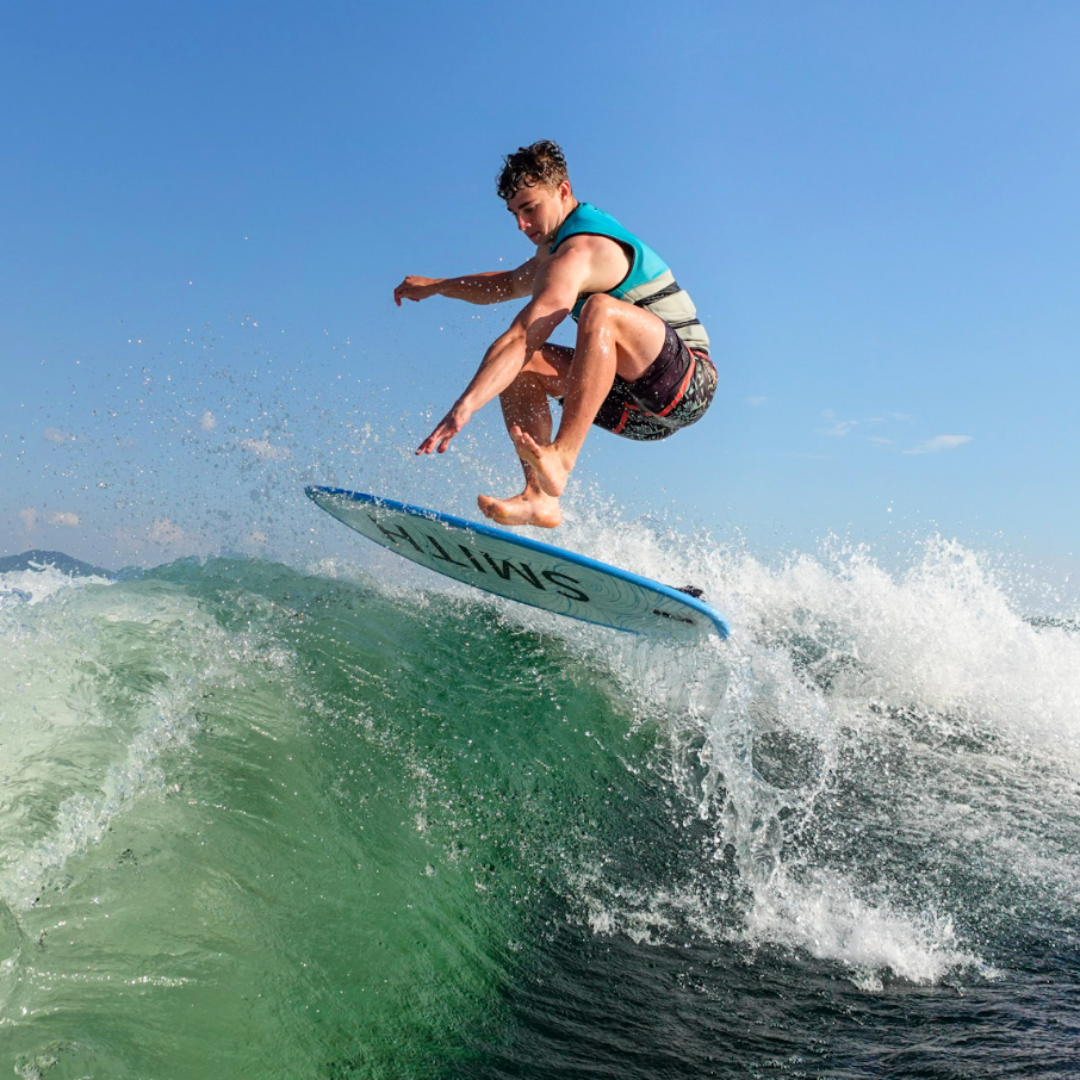
The Physics of Movement: How Biomechanics Drives Wakesurfing Performance
Share
When you're wakesurfing, every movement you make is a balance of physics and biomechanics. Whether you're carving back and forth or recovering from a wobble, understanding how your body interacts with the board and the water is key to unlocking consistent performance. By mastering core principles like balance, force generation, and momentum, wakesurf riders can achieve a higher level of performance on the wake.
Balance and Stability: The Foundation of Performance
What is Balance?
Balance is the ability of the riders body to maintain its center of mass over its base of support. On a wakesurf board, this equilibrium must be constantly adjusted due to the dynamic environment created by the wake and the movement of water. Riders must respond to unpredictable shifts caused by waves, boat wake, and the board itself. Balance in this context is not static but dynamic, requiring continuous micro-adjustments.
- Vestibular System: The inner ear plays a critical role in sensing motion and orientation. It detects changes in acceleration and rotational movement, sending signals to the brain to adjust posture and positioning.
- Core Muscles: These muscles stabilize the spine and pelvis, acting as a control center for transmitting forces between the upper and lower body.
- Foot Placement: Foot placement directly impacts how forces are distributed across the board. Subtle shifts in weight toward the toes or heels can compensate for instability or direct movement.
Dynamic balance requires integration between sensory input (from the vestibular system, vision, and proprioception) and motor responses. Without this integration, maintaining an upright position on the board would be nearly impossible.
Force Generation: Propelling You Forward
What is Force Generation?
Force generation in wakesurfing refers to the ability to create energy that moves the board through the water. This is accomplished primarily by applying pressure to the water through the board, with the legs acting as the primary source of power. Force is the result of muscular contractions, which are translated into movement through biomechanical chains.
- Muscular Force: The quadriceps, glutes, hamstrings, and calf muscles are the main contributors. These muscles work together to push against the water through the board, creating the reaction force needed to propel the rider forward.
- Coordination of Movement: Effective force generation requires precise timing and coordination between muscle groups. For instance, pressing the back foot into the water while shifting weight forward engages both lower and upper body mechanics.
- Lever Systems in the Body: The skeletal system acts as a series of levers, with the muscles providing the force to move them. In wakesurfing, the legs act as a lever arm that pushes against the resistance of the water.
This biomechanical process mirrors activities like skateboarding or snowboarding, where the rider generates forward momentum by pushing off the ground or snow.
Momentum and Torque: Controlling Movement and Rotation
What is Momentum?
Momentum is the product of an object’s mass and velocity, describing its tendency to continue moving unless acted upon by an external force. In wakesurfing, momentum allows the rider to maintain forward motion after an initial movement. The board and rider move as a combined system, with the mass of the rider playing a significant role in determining how momentum is maintained.
- Linear Momentum: Once the rider achieves a forward motion, the goal is to sustain it with minimal energy expenditure. Changes in body position, such as shifting weight slightly forward, can reduce drag and help maintain this momentum.
- External Forces: Factors like water resistance, friction, and drag constantly act against momentum. The rider must use body positioning to counteract these forces and sustain speed.
What is Torque?
Torque is a measure of rotational force applied to an object. In wakesurfing, torque is essential for initiating turns, carves, and tricks that involve rotation, such as spins.
- Rotational Force Generation: Torque is created by applying force at a distance from the axis of rotation. For example, leaning to one side of the board creates a rotational effect that allows the board to carve or change direction.
- Angular Momentum: In tricks involving spins, angular momentum comes into play. By pulling the arms closer to the body during rotation, the rider can increase the speed of the spin, thanks to the conservation of angular momentum.
- Counterbalancing Forces: To control torque, the rider must carefully balance the rotational forces with opposing forces generated by the water. Improper management of these forces can lead to instability or loss of control.
Momentum and torque are interrelated, as maintaining one often enhances the ability to execute the other. For example, a rider with sustained momentum can apply torque more effectively to execute a carve or spin.
The Interconnectedness of Biomechanics
Balance, force generation, momentum, and torque do not exist in isolation. These principles work together as part of a larger biomechanical system.
- Force generation builds momentum: A strong push off the back foot creates the initial forward motion.
- Momentum supports balance: Sustained forward motion reduces the frequency of adjustments needed to maintain stability.
- Torque enhances directional control: By leveraging momentum, the rider can more easily carve or initiate spins.
Understanding and optimizing these components is the first step toward improved performance on the wake. Next, we’ll explore how these principles translate into speed and power for wakesurfing performance.
